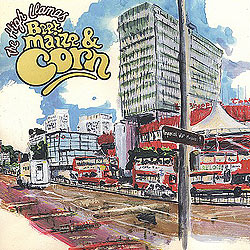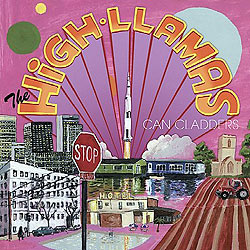Painters Paint: The Definitive Career-Spanning Interview (to date) With The High Llamas’ Sean O’Hagan
Published on January 30th, 2011 in: All You Need Is Now, Current Faves, Interviews, Issues, Music |Popshifter: Well, the last laugh seems to have been on V2, as you then released the gorgeous Beet, Maize & Corn in 2003. Before I start rhapsodizing about this album, what was happening in the interim from 2000 to 2003? I remember thinking (as did others), “I hope the guys are still together.”
Sean O’Hagan: Drag City stepped in on Buzzle Bee along with Duophonic in the UK. They are our life partners. As for V2, well, there were some great people there but in the end the ones that counted did not understand where we came from. I have no idea whether V2 regretted losing us. I think they barely gave it any thought. Unfortunately these companies are run by people that are doing jobs and might not take their passion home with them. No one lost any sleep. There was no question as to how we would carry on.

The High Llamas make records every three years and we try to defy the norm of aging artists completely losing the plot and making embarrassing music or reforming for cabaret renditions of their back catalogue. We are a social club in a way, a social club that makes a record every three years and if we can tour as well, all the better.
Popshifter: Beet, Maize & Corn is another one of those trademark, lovely, sharp turns that the High Llamas make. The instrumental bedrock of this album seems to be strings, piano, and acoustic guitar. It’s a gentle album. An album out-of-time. When questioned about the prevailing influences, you were citing Bizet, among others. Now one of the things that fans will love to know, if they don’t already: much of this album was initially recorded at home, with the vocals being recorded in your son’s bedroom because it had the best ambience! How did you feel about moving much of the recording base to right under your own roof? I mean, financially, it might have been a matter of necessity, but creatively speaking did it feel “right” or “good”? I ask because you showed that a masterpiece could be recorded at home.
Sean O’Hagan: By the time Beet, Maize & Corn happened we had made a lot of records, with so many ideas and so many ambitions. I was a bit jaded and could not face the idea of complexity. I was at home with a young family, and we really could not afford to use studios or even tour.
Anyway, Fulton Dingley who had superbly been at the helm of Cold and Bouncy and Buzzle Bee, was still with us on Beet, Maize & Corn. He convinced me that we could literally record it all at home. We recorded strings and brass in a small room in Streatham, and everything else was at home.
I was listening to [Georges] Bizet and [Frederick] Delius and becoming educated in pre-serialism, late nineteenth to early twentieth century French and English music.
I grew up in a house with out any classical (I hate the word) music and through my exploration of string writing I became excited about the prospect of reliving the excitement of discovery through [William] Walton, Frank Bridge, Delius, [Benjamin] Britten, [Kurt] Weill, and Ravel.
The classical mates I had probably thought this all very regressive as again it was tonal, though I love [Alban] Berg amongst them.
I saw this album as simple, wood parlor room, numerous in voice.
Popshifter: OK, have to ask: Why the painting of the Elephant & Castle as the sleeve design?
Sean O’Hagan: The painting of the Elephant & Castle was a cover vision that I had landed on, leaning on Impressionism and trying to make the point by having Jeremy Glogan painting a wrongly reviled building in this style. It was the beginning of a trilogy of covers to explore this idea.
Popshifter: Architecture seems to be a side fascination for you, if I’m not mistaken (judging by other album sleeves). What’s the allure for you, Sean?
Sean O’Hagan: OK, I do not write about humanity or the personal. I do, however, write about the immediate environment in which we live, the canvas of life, the everyday. Buildings are so important within our life experience and the design and non-design affects happiness or affects shutdown. I cannot but write about that. Buildings push themselves to the front of my consciousness. However, words create storyboards for songs, as you already know. I work the buildings in to this. The point you make is what draws Jonathan Coe [English novelist and writer] to the Llamas’ music as well.
Popshifter: What grabs me about Beet, Maize & Corn is that it feels as equally cinematic as Hawaii did. I see a sort of kinship between those two particular albums. This begs the question: When you prepare an album, are you trying to funnel all the songs toward one particular ethos? Or does it just shake down that way in the aftermath?

Sean O’Hagan: I think the music of a particular record has a small vision and then a shake down to end up with an overall sound. With Hawaii there was a vision from the beginning; with Beet, Maize & Corn circumstances dictated a vision that I embraced and then chased with ambition: the gentle autumn sparseness, the idea of the troubadour coming upon a set of songs. England was very much with me at the time, and I wanted to make an English record.
Popshifter: This takes us up to 2007’s Can Cladders. The albums now are appearing to arrive in three-year gaps, or so. You had fervently cited Laura Nyro as being an almost musical presence on this album, and I can see it—it’s more soulful and the piano has that funkier sound to it. In addition, there’s a sort of happy-dizzy Free-Design feel to the group vocals. Can Cladders sounds like a man at peace and at ease with his surroundings. Am I on the mark?
Sean O’Hagan: Can Cladders. Simple. It was time for a happy record. It was time to bring in a few new voices and it was time to acknowledge the great pop of ’60s American R&B. It was time to nod to Laura Nyro, The Chiffons, La Belle, The Supremes, Minnie Ripperton. But that did not mean giving up on the methods we employ. This was going to be the High Llamas making their music and visiting this joy that had not been explored for a while.
It was a very live record as well.
Popshifter: “Sailing Bells” is my favorite of the songs here—what inspired that one? The melody is sublime.
Sean O’Hagan: “Sailing Bells”: Ah, I think I might have been toying with experimental chord changes, after listening to Basil Kirchin and then superimposed some folky mansong thing until we reach the middle 8 where I wanted a kind of Churchy call response vocal moment. That middle 8 is sung to my children in my head, every time.
I was also thankful to Dorothy Ashby for being my inspiration on a lot of the record.
Popshifter: So now we’ve reached the arbitrary three-year mark: What is next on the horizon for The High Llamas?
Sean O’Hagan: OK, Talahomi Way is being released on April 11. It’s an up record with some reflective moments, some Brazilian feels and. . . I’m too close to it. I want you to hear it.
I hope the press gives us a fair hearing. I hope we are not dismissed as being unambitious and actually pointless, etc. We put so much into these records and there is a love of humanity. And even though I do not write about this, the humanity is in the melody and chords. Honesty and humanity, it’s not about posing or reflected glory . . . pure honesty and humanity.
Popshifter: Thank you very much, Sean, for sharing your thoughts.
Sean O’Hagan: Thank you, John, for listening and allowing me to speak.
For more on The High Llamas please check out their website.
Click to read more about . . .
Santa Barbara
Gideon Gaye and Hawaii
Cold and Bouncy and Lollo Rosso
Snowbug and Buzzle Bee
Beet, Maize & Corn, Can Cladders, and the upcoming Talahomi Way
8 Responses to “Painters Paint: The Definitive Career-Spanning Interview (to date) With The High Llamas’ Sean O’Hagan”
January 31st, 2011 at 10:10 am
An amazing interview.. thank you so much!
January 31st, 2011 at 12:33 pm
Wow! Awesome job! We’re kindred souls. Like you, I have loved the High Llamas since the release and discovery of “Hawaii.” Thoroughly enjoyed your interview; you asked many of the questions I’ve had for years…and does it ever have me stoked for April 11.
January 31st, 2011 at 1:19 pm
I’ve passionately loved the Llamas ages! It amazes me how much of their music I’ve still not heard; I got stuck on Cold and Bouncy and hardly budged. It’s one of my examples of a completely perfect record. Love this interview!
February 2nd, 2011 at 12:39 pm
Big Llamas fan here, very happy to get such in-depth insight into Sean’s relationship with his work. I had the pleasure of seeing Sean and the band play a show around Christmas at a town hall north of Camden after the release of Hawaii, and I have fond memories of the show, which was spectacular. I hope to see them again!
February 2nd, 2011 at 5:58 pm
Thank U Thank U Thank U for this! Fantastic interview…Bravo. The passionate few of the world are still here – living each day with an appreciation for the Llamas that grows and with continued hope for their successful return. The next couple of months will be sweet agony.
BTW – I saw the HL show at the Black Cat in 2004, haven’t been back there since.
February 11th, 2011 at 7:11 am
All Llamas fans will surely get a big kick out of the new Ocean Tango album, which is actually a collaboration between Louis Philippe and the excellent Swedish band Testbild! Sean is a big fan of both and even gets to play on the album, which can be found at http://oceantango.bandcamp.com. Needless to say, the British media have so far given it a wide berth . . . sigh . . .
February 14th, 2011 at 2:21 pm
Great interview. For a “non-college” guy, Sean is certainly articulate and thoughtful in his speech and music. I liked how he said “Snowbug” was his favorite Llamas album, because it is now my favorite, even though I have only it owned it for a month. The fade-out to “Go To Montecito” could go on all night and I would never stop grooving to it…never heard any of the post-Snowbug albums but I will get to them all, I know. Thanks Sean, for such sublime music. Hope you can get to America and tour again…saw you in Pontiac, MI at a club show in the late 90s….can’t remember what year exactly.
September 19th, 2012 at 8:01 pm
[…] Again we were drunk on experimentation: wheeling in rank pianos, recording impossibly thin buzz guitars, and for the first time I was experimenting with string writing. As the ideas fell upon themselves, and it all worked, the architecture of the band just started to build itself before us. (read the whole interview with Sean O’Hagan by John Lane). […]
Time limit is exhausted. Please reload the CAPTCHA.